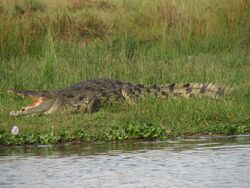Biology:Crocodyloidea
| Crocodyloidea | |
|---|---|

| |
| Crocodylus niloticus (Nile crocodile) | |
| Scientific classification | |
| Domain: | Eukaryota |
| Kingdom: | Animalia |
| Phylum: | Chordata |
| Class: | Reptilia |
| Clade: | Archosauromorpha |
| Clade: | Archosauriformes |
| Order: | Crocodilia |
| Clade: | Longirostres |
| Superfamily: | Crocodyloidea Fitzinger, 1826 |
| Subgroups | |
| |
Crocodyloidea is one of three superfamilies of crocodilians, the other two being Alligatoroidea and Gavialoidea, and it includes the crocodiles. Crocodyloidea may also include the extinct Mekosuchinae,[1][2] native to Australasia from the Eocene to the Holocene, although this is disputed.[3][4]
Classification
Cladistically, it is defined as Crocodylus niloticus (the Nile crocodile) and all crocodylians more closely related to C. niloticus than to either Alligator mississippiensis (the American alligator) or Gavialis gangeticus (the gharial).[5] This is a stem-based definition for crocodiles, and is more inclusive than the crown group Crocodylidae.[3] As a crown group, Crocodylidae only includes the last common ancestor of all extant (living) crocodiles and their descendants (living or extinct), whereas Crocodyloidea, as a stem group, also includes more basal extinct crocodile ancestors that are more closely related to living crocodiles than to alligators or gavialids. When considering only living taxa (neontology), this makes Crocodyloidea and Crocodylidae synonymous, and only Crocodylidae is used. Thus, Crocodyloidea is only used in the context of paleontology.
Traditionally, crocodiles and alligators were considered more closely related and grouped together in the clade Brevirostres, to the exclusion of the gharials. This classification was based on morphological studies primarily focused on analyzing skeletal traits of living and extinct fossil species.[6] However, recent molecular studies using DNA sequencing have rejected Brevirostres upon finding the crocodiles and gavialids to be more closely related than the alligators.[7][8][9][3][4] The new clade Longirostres was named by Harshman et al. in 2003.[7]
A 2018 tip dating study by Lee & Yates simultaneously using morphological, molecular (DNA sequencing), and stratigraphic (fossil age) data established the inter-relationships within Crocodilia,[3] which was expanded upon in 2021 by Hekkala et al. using paleogenomics by extracting DNA from the extinct Voay.[4]
The below cladogram shows the results of the latest study, and how Crocodyloidea may only contain one additional taxon beyond Crocodylidae:
| Crocodylia |
| ||||||||||||||||||||||||||||||||||||||||||||||||||||||||||||||||||||||||
| (crown group) |
References
- ↑ Stein, Michael D.; Yates, Adam; Hand, Suzanne J.; Archer, Michael (2017). "Variation in the pelvic and pectoral girdles of Australian Oligo–Miocene mekosuchine crocodiles with implications for locomotion and habitus". PeerJ 5: e3501. doi:10.7717/peerj.3501. PMID 28674657.
- ↑ Iijima, M.; Kobayashi, Y. (2019). "Mosaic nature in the skeleton of East Asian crocodylians fills the morphological gap between "Tomistominae" and Gavialinae". Cladistics 35 (6): 623–632. doi:10.1111/cla.12372. PMID 34618925. https://www.researchgate.net/publication/330510735.
- ↑ 3.0 3.1 3.2 3.3 Michael S. Y. Lee; Adam M. Yates (27 June 2018). "Tip-dating and homoplasy: reconciling the shallow molecular divergences of modern gharials with their long fossil". Proceedings of the Royal Society B 285 (1881). doi:10.1098/rspb.2018.1071. PMID 30051855.
- ↑ 4.0 4.1 4.2 Hekkala, E.; Gatesy, J.; Narechania, A.; Meredith, R.; Russello, M.; Aardema, M. L.; Jensen, E.; Montanari, S. et al. (2021-04-27). "Paleogenomics illuminates the evolutionary history of the extinct Holocene "horned" crocodile of Madagascar, Voay robustus" (in en). Communications Biology 4 (1): 505. doi:10.1038/s42003-021-02017-0. ISSN 2399-3642. PMID 33907305.
- ↑ Brochu, Christopher A. (May 2003). "Phylogenetic approaches toward crocodylian history". Annual Review of Earth and Planetary Sciences 31 (31): 360. doi:10.1146/annurev.earth.31.100901.141308. Bibcode: 2003AREPS..31..357B.
- ↑ Holliday, Casey M.; Gardner, Nicholas M. (2012). Farke, Andrew A. ed. "A new eusuchian crocodyliform with novel cranial integument and its significance for the origin and evolution of Crocodylia". PLOS ONE 7 (1): e30471. doi:10.1371/journal.pone.0030471. PMID 22303441. Bibcode: 2012PLoSO...730471H.
- ↑ 7.0 7.1 Harshman, J.; Huddleston, C. J.; Bollback, J. P.; Parsons, T. J.; Braun, M. J. (2003). "True and false gharials: A nuclear gene phylogeny of crocodylia". Systematic Biology 52 (3): 386–402. doi:10.1080/10635150309323. PMID 12775527. http://si-pddr.si.edu/bitstream/handle/10088/6275/2003C_Harshman_et_al.pdf. Retrieved 2021-06-25.
- ↑ Gatesy, J.; Amato, G. (2008). "The rapid accumulation of consistent molecular support for intergeneric crocodylian relationships". Molecular Phylogenetics and Evolution 48 (3): 1232–1237. doi:10.1016/j.ympev.2008.02.009. PMID 18372192.
- ↑ Erickson, G. M.; Gignac, P. M.; Steppan, S. J.; Lappin, A. K.; Vliet, K. A.; Brueggen, J. A.; Inouye, B. D.; Kledzik, D. et al. (2012). Claessens, Leon. ed. "Insights into the ecology and evolutionary success of crocodilians revealed through bite-force and tooth-pressure experimentation". PLOS ONE 7 (3): e31781. doi:10.1371/journal.pone.0031781. PMID 22431965. Bibcode: 2012PLoSO...731781E.
Wikidata ☰ Q978254 entry
 |

